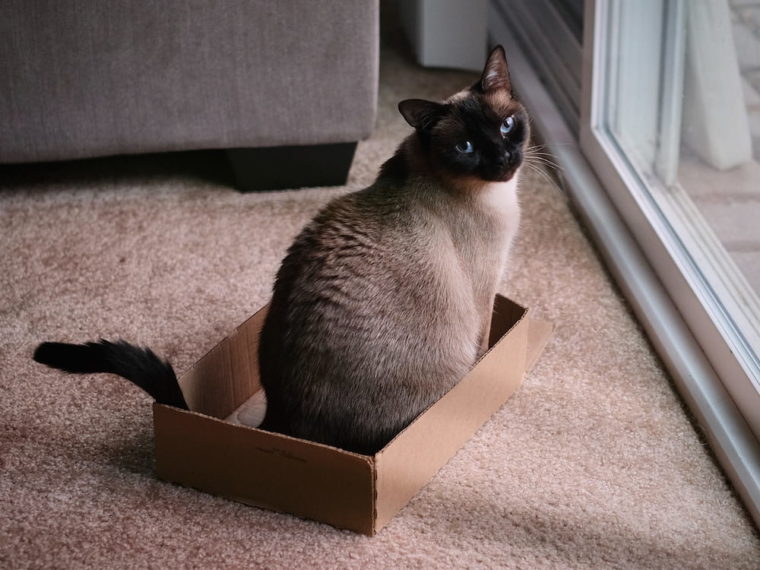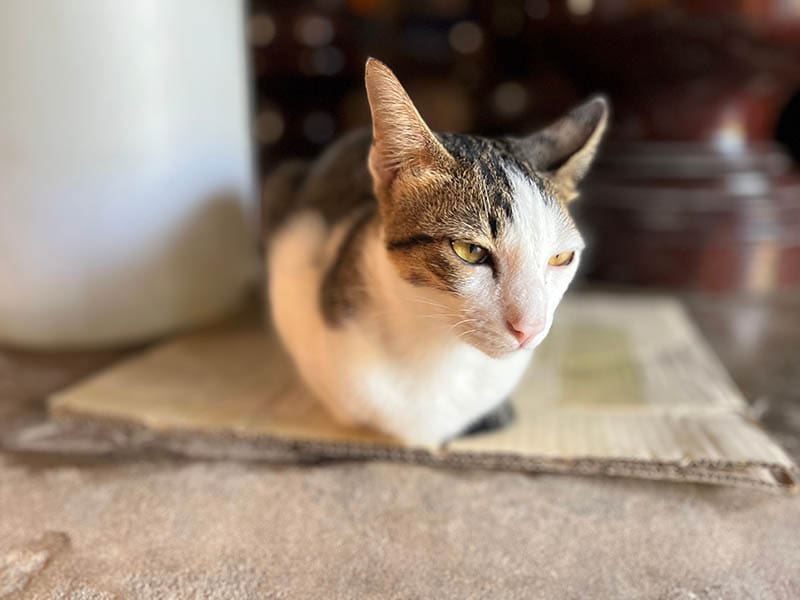
Cats can comfortably stay inside a square shape, even if it is just taped on the floor, regardless of how small or big the square is. Whether the behavior is intentional or because of something else, most people have been using the square tape method to amuse themselves and their cats.
While experts have been trying to come up with an explanation for this behavior, the most plausible one came from research studies which found out that not only are cats fond of sitting inside boxes, but two-dimensional shapes that look like squares are also appealing to them.
This article will investigate this phenomenon further and highlight possible reasons why your cat will want to sit on squares, including tape squares.

8 Possible Reasons Why Cats Sit on Squares
1. Marking Their Territory
When your cat sits on a taped-off square or a square-shaped object, this could simply be her way of marking the territory. Instinctively, they may want to stake out a small portion of space as their own and sitting on top can help them do that.
Sitting on their preferred portion of the surface will also help the cat release their scent, thus claiming the square as their haven.

2. For a Sense of Security
Usually, square enclosed spaces give cats a sense of security, especially if they feel threatened in their immediate environment. Therefore, they will want to sit in a square to feel safer and more secure. Your cat will even be able to discern that the taped-off squares have defined edges, allowing it to see it as an enclosed area even though it’s not necessarily a bed or a cardboard box.
3. Perfect Fit
When cats are looking for a comfortable place to take a nap, they have an uncanny ability to find an area that is the perfect fit for their body shape. Cats have a natural preference for rectangles and squares over other shapes. This is probably because they know the shapes that can accommodate their unique body shape better than others would.

4. Comfort
In some instances, some squares may be soft (because they are made from folded blankets and thick pillows), thus making them comfortable to relax and lounge on. Moreover, square sides also offer extra cushioning, thus protecting your cat from the hard surfaces beneath it.
5. Familiarity
When cats are raised with a rectangular or square-shaped bed, they might get comfortable and familiar with the bed as a surface to sleep on. This is usually why most owners may find their cats sleeping in the same position every day because they have made the square shape their comfort area.

6. Temperature Regulation
Squares and rectangles are better fitted for temperature distribution, more than other shapes. This can be quite useful, especially on hot summer days—and perhaps why commercially produced and sold cat beds feature a square shape. Since the sides of the square can act as an insulator, the shape helps keep your cat cooler than it would be when lying on its back, even in an open-air environment.
7. Balance
Generally, Cats may sleep in square-shaped objects because it helps them get their balance better than with other shapes. This especially applies to older cats and those suffering from physical disabilities that find it especially hard to balance their bodies on their own.

8. Pure Curiosity
As we all know, cats are generally very curious creatures. So, they might be intrigued and want to sit and spend time in the shape of rectangles and squares. They will probably want to explore and find out exactly what makes them different from other shapes at their disposal.
What Do Scientists Say?
According to a myth debunking site, a study of the cats in a square phenomenon revealed the claims that a cat will automatically sit on squares, especially those taped to floors as false. Based on the results, cats will definitely get curious about an unusual square sticking out of a floor. However, this doesn’t necessarily mean that the cat will always sit and stay in the square for a while.
So, this phenomenon may not be the norm in all cats. But what do scientists have to say?

Cats Have Illusory Contour Perception
Scientists have also been fascinated with this peculiar cat behavior, leading researchers to study cat reasoning and whether cats can recognize square-shaped optical illusions.
According to the researchers, cats feature an illusory contour perception. A box doesn’t have to be in three dimensions to be appealing to a cat. They can happily curl up and relax in a taped square or the illusion of a square.
The Phenomenon Is Only Seen in Nesting Cats
On the other hand, some animal behaviorists and other scientists also claim that this behavior is only observed in nesting cats. When female cats are expectant, they prepare for their offspring by making nests.
This nesting behavior involves your cat looking for a warm and cozy place to snuggle. During this period, you might find your cat spending too much time in a specific spot, either in a box or a simple nook or corner in your home.
To this faction, this is the closest behavior that remotely resembles cats sitting in a square. So, to them, the claim that your cat will always sit in a square is legitimately wrong. If your cat loves sitting on squares, it is purely coincidental and is not an indication of your cat’s natural inclinations whatsoever.

Tips for Keeping Your Cat Safe and Happy
As you may have gathered, cats may get attracted to sit on square objects for various reasons. If they happen to be sitting on a useful house commodity, or something that could potentially injure the cat, you should try and stop your cat from lying on it. While it may not be easy to stop a cat from sitting on your things, you can at least protect your belongings by securing them where cats can’t reach.
It is also important to make sure that your cat receives enough attention, playtime, and mental/physical stimulation. If they are lonely or feeling bored, they are likely to look for attention by interacting with your belongings.
You should also make sure that you provide your cat with a cozy, enclosed space to help keep it warm and secure when faced with stressful situations. If things get overwhelming, they can sneak into the space and hide. This is actually what prompts them to seek out square objects in the first place. To sweeten the deal, add one of his favorite toys in the enclosed area.

Conclusion
Although there is so much information on cat-related behavior, we still do not know much about cats and their sometimes borderline strange behaviors. However, it’s always best to find the truth instead of relying on misinformation that is replete on the internet.
In that regard, while many people might assume that cats will always automatically want to sit on square shapes and spend some time in the area, it might be coincidental. As much as people share video shreds of evidence of this phenomenon, it doesn’t necessarily mean that cats are instinctively drawn to square surfaces.
They only do so for some of the reasons highlighted in our article, which mostly revolve around looking for a safe and secure spot to while away their time.
Featured Image Credit: Andrew Cornell, Unsplash





